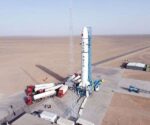The future USS John F. Kennedy (CVN-79), the U.S. Navy’s second Ford-class aircraft carrier, has successfully completed critical propulsion plant testing at Huntington Ingalls Industries’ (HII) Newport News Shipbuilding division. This milestone marks a major step toward the ship’s first sea trials scheduled for 2026 and eventual delivery to the fleet.
Propulsion Plant Testing Completed at Newport News
Newport News Shipbuilding announced in late September 2025 that CVN-79 had successfully completed its propulsion plant testing phase—a series of evaluations designed to verify the performance and integrity of the ship’s dual nuclear reactors and associated systems.
The testing included initial reactor startup procedures, steam generation assessments, main engine operations, and shaft rotation verification. These steps are essential to ensure that the nuclear-powered carrier can safely generate and transmit power for propulsion and onboard systems under operational conditions.
According to HII officials, this effort required close coordination between shipyard personnel, Naval Reactors representatives, and U.S. Navy engineers. The successful completion of these tests confirms that all four main turbine generators and both propulsion shafts are functioning as designed.
Ford-Class Design Evolution and CVN-79 Enhancements
As the second ship in the Ford-class after USS Gerald R. Ford (CVN-78), CVN-79 incorporates numerous design improvements based on lessons learned from its predecessor’s construction and early operational experience.
- Reduced construction rework: Over 77% of CVN-79 was built in modular units before being installed on the ship—a significant increase from CVN-78—streamlining assembly and reducing cost overruns.
- Simplified island structure: The island on CVN-79 was redesigned with fewer parts and improved radar cross-section characteristics.
- Improved EMALS & AAG integration: The Electromagnetic Aircraft Launch System (EMALS) and Advanced Arresting Gear (AAG) have been refined for reliability based on feedback from CVN-78 operations.
The Ford-class carriers represent a generational leap over Nimitz-class predecessors with innovations such as:
- A new dual-reactor A1B nuclear power plant offering three times more electrical output than Nimitz-class A4W reactors
- An all-electric architecture enabling future directed energy weapons or electromagnetic systems
- A smaller crew requirement (~2/3 of Nimitz class) due to automation improvements
Sea Trials Timeline and Delivery Outlook
The successful propulsion test clears a major hurdle ahead of integrated sea trials expected in mid-to-late 2026. These trials will evaluate overall ship performance—including navigation systems, combat systems integration, aviation facilities readiness (e.g., EMALS/AAG), communications suites, radar arrays (notably AN/SPY-3), damage control systems, and crew habitability.
If no major delays occur during sea trials or final outfitting phases—including weapons elevator certifications—the Navy anticipates taking delivery of CVN-79 by late FY2027 or early FY2028. This would align with current Congressional Budget Office projections but remains subject to funding adjustments or technical setbacks.
Crew Onboarding and Training Underway
The precommissioning unit (PCU) crew assigned to John F. Kennedy has been gradually increasing since early 2024 as spaces become habitable aboard the vessel. Sailors are undergoing training on reactor operations, navigation systems, aviation support equipment, medical facilities readiness checks, cybersecurity protocols for C4ISR networks onboard—and more recently—aviation fueling simulations using EMALS interfaces.
This phased onboarding ensures that once sea trials commence in earnest next year, key watch stations across engineering control centers (ECCs), bridge operations rooms (BORs), flight deck command centers (FDCCs), etc., will be manned by trained personnel familiar with Ford-class-specific technologies.
Strategic Role Within Future Carrier Strike Groups
Certain to become a flagship within future Carrier Strike Groups (CSGs), USS John F. Kennedy will provide enhanced sortie generation rates—up to a projected 25% increase over Nimitz-class ships—thanks to an optimized flight deck layout featuring dual-band radar integration with improved air traffic control zones.
This capability is particularly relevant given evolving peer threats from China’s PLAN carrier fleet expansion or Russia’s long-range strike platforms like Kinzhal-equipped MiG-31Ks or Zircon-equipped surface vessels/submarines operating in contested maritime zones such as the Arctic or Western Pacific theaters.
The increased electrical capacity also positions CVN-79 as a testbed for integrating emerging directed energy weapons like HELIOS lasers or electronic warfare payloads requiring high onboard power draw—a future-proofing element baked into Ford-class architecture from inception.
Conclusion: A Milestone Toward Next Generation Naval Power Projection
The completion of propulsion system testing aboard USS John F. Kennedy marks more than just another construction milestone—it signals progress toward deploying a fully modernized aircraft carrier capable of supporting distributed maritime operations well into mid-century conflict scenarios involving peer adversaries across multiple domains.
If subsequent milestones proceed without delay—including combat system activation and full flight deck certification—CVN-79 is poised to enter service as one of the most technologically advanced capital ships ever fielded by any navy worldwide.








